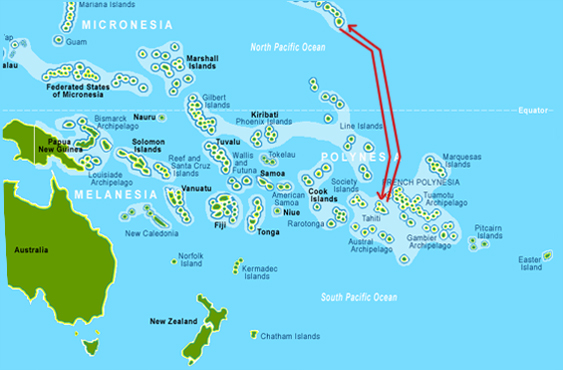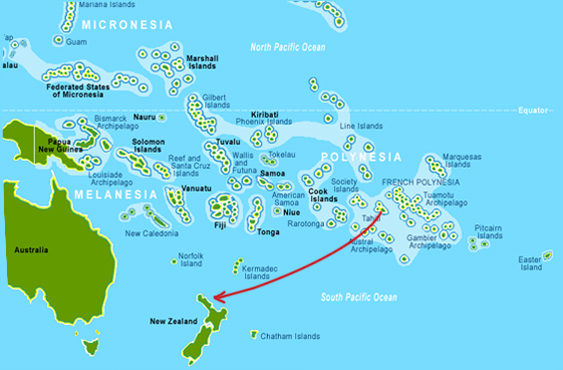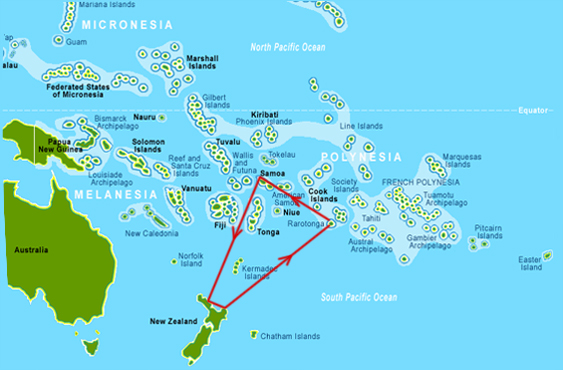1936-37
Kaimiloa
(double hull):
Hawaii -> France
The Canoe Is the People
Indigenous Navigation in the Pacific
Modern Voyages
The story of revival is the story of people weaving into each other’s lives like the strands of a mat. The whole mat would not be complete without all their experiences and thoughts.
Use the slider on the timeline to explore some of these voyages.


Mau's fame as a navigator came from a voyage he made in 1976, when he guided the Hokulea, a replica (copy) of an ancient Polynesian sailing canoe, from Hawaii to Tahiti. It was an extraordinary achievement. 3000 miles (4828 km) across waters he'd never sailed before. 40 days without sight of land. He slept for no more than a half hour at a time, but his daily estimates of position were never more than 40 miles (64 km) off. Many nights, it was cloudy, without even the stars to guide him.
From The Last Navigator © INCA 1989. Directed by Andre Singer.


1936-37
Kaimiloa (double hull): Hawaii -> France
When he built the Kaimiloa, Eric de Bisschop was inspired by Pacific voyaging canoes and guided by the indigenous people of Hawaii. However, he used modern building materials and methods. For example, he joined the two hulls together with old car springs instead of tying them to wooden beams (long pieces of strong wood). After many adventures, he successed in sailing west across the Pacific and Indian Oceans and then around Africa to France.

1947
Kon-Tiki
(raft):
Peru -> Tuamotu Islands
1947
Kon-Tiki (raft): Peru -> Tuamotu Islands
Thor Heyerdahl didn't believe that canoe voyagers from South-east Asia could have sailed east to Polynesia against the trade winds (winds that blow steadily towards the equator for half the year - from the south-east south of the equator and from the north-east north of the equator) and currents. He thought that raft voyagers from South America were the first people to reach Polynesia. To support his idea, he built the raft Kon-Tiki from light balsa wood. He sailed it from Peru to the Tuamotu Islands of Polynesia. However, after studies of languages, cultures, and artifacts (objects created by people) from the area, modern researchers believe that Heyerdahl's theory is incorrect.
Note: After landing in the Tuamotus, Kon-Tiki was shipped to Tahiti and then to Oslo in Norway, where it is now in a museum.

1956-58
Tahiti-Nui
(raft):
Tahiti -> off Chile
Tahiti-Nui II
(raft):
Peru -> northern Cook Islands
1956-58
Tahiti-Nui (raft): Tahiti -> off Chile
Tahiti-Nui II (raft): Peru -> northern Cook Islands
After Kon-Tiki's voyage, Eric de Bisschop wanted to prove that Polynesians could have sailed by raft to South America. He built Tahiti-Nui (a bamboo raft) and sailed south from Tahiti to catch the west winds east. Tahitian navigator Francis Cowan went with him. However, he and his crew had to abandon (leave) the broken raft near Chile. They were rescued by the Chilean navy. Later, they sailed back to Polynesia on Tahiti-Nui II, a raft made from cyprus wood. As they neared Polynesia, it began to fall apart and sink. It finally crashed onto the coral reef of Rakahanga in the northern Cook Islands, killing De Bisschop.

1964
Rehu Moana
(catamaran):
Tahiti -> Aotearoa
1964
Tangaroa
(catamaran):
Atlantic Crossing
1964
Rehu Moana (catamaran): Tahiti -> Aotearoa
New Zealander David Lewis sailed a modern catamaran from Tahiti to Aotearoa (New Zealand), navigating by the stars in the old Polynesian way. He made one mistake in the Cook Islands, but his voyage still showed that it is possible to navigate without instruments over long distances. Afterwards, he sailed around the Pacific on a yacht. He learned from traditional navigators like Hipour (of Puluwat atoll in Micronesia) and Tavake (of Taumako Island off the eastern end of the Solomon Islands). His book We, the Navigators is still the most complete book about Pacific navigation.
1964
Tangaroa (catamaran): Atlantic Crossing
Englishman James Wharram wanted to make yachting something for everyone, not just the rich. He mixed the design of the double-hulled voyaging canoe with European building materials. First, he crossed the Atlantic in a basic catamaran (double-hulled sailing boat based on the Polynesian double-hulled canoe). In the Caribbean, he made a better catamaran and sailed back to England. Since then, many sailors worldwide have successfully built and sailed boats that Wharram has designed.

1965-66
Nalehia
(double hull):
Hawaiian Islands
1965-66
Nalehia (double hull): Hawaiian Islands
In the mid-1960s, a New Zealand historian named Andrew Sharp claimed that the Polynesians did not explore and settle the Pacific on purpose. He said that their canoes and ways of navigation weren't good enough. He argued that they'd been blown to the islands by storms and bad winds. To show that Sharp was wrong, anthropologist (person who studies human cultures) Ben Finney started a project to build double-hulled canoes. He wanted to test these canoes on long voyages and recover the old ways of navigating. The first tests were made with Nalehia, a copy of a Hawaiian double hull. The tests showed how well double hulls could sail on the open ocean. They provided the information needed to build the big voyaging canoe Hokulea and sail it to Tahiti.

1970
Maiisukul
(single outrigger):
Satawal -> Pikelot -> Saipan
1970
Maiisukul (single outrigger): Satawal -> Pikelot -> Saipan
The name Maiisukul means "his first teaching canoe of breadfruit wood", referring to Rasemai, who used it when he began to teach navigation. Rasemai and the canoe belonged to Asuukwow canoe house in southern Satawal, where Rasemai had married. For the trip to Saipan, Repwanglug borrowed the canoe from Rasemai/Asuukwow.
The voyage of Repwanglug and his crew re-opened the sea lanes from the Carolines to the Marianas. In the next decades many other voyages within the Carolines were made, although they were not officially recorded.

1976
Hokulea
(double hull):
Hawaii -> Tahiti -> Hawaii
1976
Hokulea (double hull): Hawaii -> Tahiti -> Hawaii
Hawaiian artist Herb Kane designed Hokulea, a 19-metre-long voyaging canoe. Hokulea was built mostly with modern materials (plywood hulls and cloth sails). However, it sailed like a traditional canoe. At the launch in March 1975, Kane blessed it: Eia ka waa i kalai ia; e kapaia hainoa o Hokulea. Ke ui aku nei na alakai o ka po, na alakai o ke ao, na alakai o luna, na alakai o lalo. (this is the canoe that has been built; its name is to be Hokulea. Ask our gods of po and of ao, from above, from below to bless it.)
From a piece by Kenneth Emory on http://leahi.kcc.hawaii.edu/org/pvs/launching.html
No old Polynesian navigators were available to guide Hokulea from Hawaii to Tahiti, so Ben Finney brought a master navigator from Satawal, Micronesia. His name was Mau Piailug. Hokulea arrived in Tahiti to a great welcome and then voyaged home. Mau has since played a huge part in the rebirth of traditional navigation. Hokulea continues to sail around the Pacific. It has become a symbol of indigenous revival, inspiring other Pacific Islanders to reconnect to their voyaging past.

1976-77
Taratai I
(single outrigger):
Kiribati -> Fiji
Taratai II (single outrigger):
Fiji -> Tonga
1976-77
Taratai I (single outrigger): Kiribati -> Fiji
Taratai II (single outrigger): Fiji -> Tonga
Taratai is a small island in Kitibati (Gilbert Islands) with few large trees. New Zealand photographer James Siers wanted to give the people of Taratai the chance to build a large voyaging canoe. He sent them wood for it. The largest piece was for the keel (structure on the bottom of a board that works against the force of the wind to keep it upright). The master canoe builder had never seen such a big piece of wood. He didn't want to cut it smaller and so made a 21-metre canoe! It had two sails which made sailing difficult. Finding wood light enough for the outrigger was also a problem.
In 1976, Siers and a crew from Taratai sailed for Tahiti but only got as far as Fiji. In 1977, they tried to complete the trip in a new plywood canoe (Taratai II), but it broke after leaving Tonga.

1980
Hokulea
(double hull):
Hawaii -> Tahiti -> Hawaii
1980
Hokulea (double hull): Hawaii -> Tahiti -> Hawaii
After the 1976 voyage, the Hawaiians sailed Hokulea back to Tahiti in 1980. Nainoa Thompson, a young Hawaiian trained by Micronesian master navigator Mau Piailug, guided the canoe. This was the first time in hundreds of years that a Polynesian had navigated a canoe so far. The voyage marked the true rebirth of long-distance voyaging in Polynesia.

1985
Hawaiki-Nui
(double hull):
Tahiti -> Aotearoa
1985
Hawaiki-Nui (double hull): Tahiti -> Aotearoa
The building of Hawaiki-Nui was a joint project between Tahitian and Maori canoe builders, led by navigator Francis Cowan and carver Matahi Avauli Brightwell. Matahi had a dream that his grandmother wanted him to rediscover the path to Hawaiki, the mythical homeland of all Maori. He went to Tahiti with his dream and two hulls that he had carved. There, Francis helped him to complete the canoe and sail it from Tahiti to Rarotonga and then on to Aotearoa (New Zealand). Unlike some other canoes, Hawaiki-Nui sailed without the support of any escort boats (modern boats that follow a canoe) or an inboard motor. The canoe was shipped back to Tahiti and displayed in the museum there.

1985-87
Hokulea
(double hull):
Hawaii -> Aotearoa -> Hawaii
1985-87
Hokulea (double hull): Hawaii -> Aotearoa -> Hawaii
The Hawaiians sailed Hokulea to Aotearoa (New Zealand) and back. They stopped at the Tuamotu Islands, Tahiti, the Cook Islands, Tonga, and Samoa. They wanted to develop Hawaiian knowledge of the rest of Polynesia and encourage other Polynesians to join in the voyaging revival. The voyage took two years because they waited for the right winds for each stage. This is the traditional way of voyaging. For example, they waited for west winds before sailing east from Samoa to Tahiti instead of going against the trade winds (winds that blow steadily towards the equator for half the year - from the south - east south of the equator and from the north-east north of the equator).

1992
Festival of Pacific Arts, Rarotonga, Cook Islands
Te Aurere (double hull): Aotearoa -> Cook Islands
Hokulea (double hull): Hawaii -> Cook Islands
Takitumu (double hull): Cook Islands
Waan Aelon Kein (outrigger): Cook Islands
1992
Festival of Pacific Arts, Rarotonga, Cook Islands
These big Pacific canoes and many smaller ones met in Rarotonga to celebrate the canoe voyaging tradition.
Takitumu (double hull): Cook Islands
Takitumu had just been built on Rarotonga by former Cook Islands Prime Minister Sir Tom Davis (Papa Tom). Takutumu is a shunting kalia. It shows the tie between the Cook Islands and the western Pacific, Tonga, and Samoa. It's one of the fastest of the long-distance voyaging canoes. Its two plywood hulls are of different sizes. The smaller one is like the float of an outrigger. It uses a triangular sail thought to have been copied from Micronesian canoes. Like those canoes, Takitumu is shunted not tacked.
Te Aurere (double hull): Aotearoa -> Cook Islands
Hokulea (double hull): Hawaii -> Cook Islands
Te Aurere sailed from Aotearoa (New Zealand) for the festival. Hekenukumaingaiwi (Hec) Busby built the canoe in 1991. Stanley Conrad was the captain. Jacko Thatcher was the navigator. After Hokulea's visit to Aotearoa in 1976, Hec wanted to build a Maori voyaging canoe with traditional materials. He feared that the knowledge could disappear, and so he wanted to rediscover canoe culture completely - from the prayer before cutting a tree down to the rituals (ceremonies) on the building site.
Waan Aelon Kein (outrigger): Cook Islands
Wann Aelon Kein is a long outrigger canoe from Eniwetok atoll of the Marshall Islands. It was built in 1991 by master canoe makers who had built and sailed big canoes when they were young. Walap isn't a long-distance canoe, so it was shipped by yacht to Aitutake atoll in the southern Cooks. From there, it sailed to Rarotonga using the Marshallese way of navigating by the ocean swells.

1995 (Feb-Mar)
Hokulea (double hull), Hawaiiloa (double hull):
Hawaii -> Raiatea
Takitumu (double hull), Te Au o Tonga (double hull):
Cook Islands -> Raiatea
Tahiti-Nui (double hull): Tahiti -> Raiatea
Te Aurere (double hull): Aotearoa -> Raiatea
1995 (Feb-Mar)
Hokulea (double hull) and Hawaiiloa (double hull): Hawaii -> Raiatea
Takitumu (double hull) and Te Au o Tonga (double hull): Cook Islands -> Raiatea
Tahiti-Nui (double hull): Tahiti -> Raiatea
Te Aurere (double hull): Aotearoa -> Raiatea
Pacific stories say that canoes from accross Polynesia used to sail to Taputapuatea marae on Raiatea (near Tahiti) to take part in rituals (ceremonies) of the faatau aroha (friendly group). Then the group was broken when people from its eastern and western sides began fighting. In 1995, canoes once again voyaged to Raiatea to celebrate the rebirth of Polynesian voyaging and the rebirth of the group.
A ceremony of forgiveness and renewal was held on the marae.
Some of the canoes were built just for the voyage. Hawaiiloa was made in Hawaii using dugout logs from Alaska. Te Au o Tonga was built from plywood in Rarotonga using a Tahitian design. Tahiti-Nui was made from the old hulls of Hawaiki-Nui.

1995 (Apr-Jun)
Hokulea (double hull), Hawaiiloa (double hull),
Makalii (double hull), Takitumu (double hull),
Te Au o Tonga (double hull), Te Aurere (double hull):
Raiatea -> Te Henua Enana -> Hawaii -> home islands
1995 (Apr-Jun)
Hokulea (double hull), Hawaiiloa (double hull),
Makalii (double hull), Takitumu (double hull),
Te Au o Tonga (double hull), Te Aurere (double hull):
Raiatea -> Te Henua Enana -> Hawaii -> home islands
Five of the canoes that were at Taputapuatea Marae in Raiatea plus Makalii (a new one with fibreglass hulls from Hawaii) sailed to Te Henua Enana (Marquesas Islands). This island is thought to be the homeland of the Hawaiians. From there, the canoes sailed together to Hawaii to remember and celebrate the discovery of these mose northern islands of Polynesia. Then they all sailed home. After Te Au o Tonga returned to Rarotonga, the Cook Islanders sailed her to French Polynesia's Tuamotu Islands to protest the testing of nuclear bombs on the atoll of Mururoa.

1996
Te Au o Tonga (double hull):
Rarotonga -> Samoa -> Aotearoa -> Rarotonga
1996
Te Au o Tonga (double hull):
Rarotonga -> Samoa -> Aotearoa -> Rarotonga
Te Au o Tonga sailed on a long voyage to Aotearoa (New Zealand), visiting events like the 7th Pacific Arts Festival in Samoa and the 1996 Waka Moana Symposium in Auckland, Aotearoa.

1999
Makalii (double hull):
Hawaii -> Satawal -> Hawaii
1999
Makalii (double hull): Hawaii -> Satawal -> Hawaii
The crew of Makalii (Hawaii's newest voyaging canoe) wanted to honour the master navigator Mau Piailug for all he'd done to help Hawaiians to revive voyaging. They sailed Mau from Hawaii back to his home island of Satawal in the Federated States of Micronesia.

1999-2000
Hokulea (double hull):
Hawaii -> Rapa Nui -> Hawaii
1999-2000
Hokulea (double hull): Hawaii -> Rapa Nui -> Hawaii
Hokulea, still strong after 25 years, succeeded in reaching Rapa Nui (Easter Island), the most eastern island of Polynesia. It stopped at Te Henua Enana(Marquesas Islands), Mangareva, and Pitcairn Island on the way. Finding Rapa Nui with traditional navigation methods was a great success. The island is very small. There are no islands around it to make a larger target. On top of that, nearly all the seabirds that once fished around the island are now gone.

2000 (Jan)
Mileniume (outrigger):
Tonga
2000 (Jan)
Mileniume (outrigger): Tonga
This 33-metre kalia (Tongan double hull) was built by Tuione Pulotu and his men in Nukualofa, Tonga, to celebrate the year 2000. They also built two smaller 12-metre kalia as trainging canoes. Tuione: "We need four men just to handle the steering paddle. In the old days, if they didn't steer right, the king of chief would knock them on the head ... and they would be replaced. We obviously can't do that sort of thing nowadays."
From www.tongahighschool.com/king_1.html (Originally from John Hamilton, Melbourne Herald Sun, July 1999.).

2000 (Feb-Apr)
Te Aurere (double hull):
Circumnavigation of North Island, Aotearoa
2000 (Feb-Apr)
Te Aurere (double hull): Circumnavigation of North Island, Aotearoa
This journey right around the North Island of Aotearoa (New Zealand) was more difficult than an open ocean voyage (for which traditional double hulls are really designed). Te Aurere visited many marae (Maori communities) on the way.

2000 (Sep-Nov)
Te Au o Tonga (double hull):
Rarotonga -> Aotearoa -> New Caledonia -> Rarotonga
Te Aurere (double hull):
Aotearoa -> New Caledonia -> Aotearoa
2000 (Sep-Nov)
Te Au o Tonga (double hull):
Rarotonga -> Aotearoa -> New Caledonia -> Rarotonga
Te Aurere (double hull):
Aotearoa -> New Caledonia -> Aotearoa
Te Au o Tonga sailed to Aotearoa (New Zealand) for the Millennium celebrations. It met up with Te Aurere in New Caledonia for the 8th Pacific Arts Festival.

2004
Hawaiki-Nui (double hull) - proposed voyage:
Tahiti -> Chile -> Cook Islands -> Aotearoa
2004
Hawaiki-Nui II (double hull) - proposed voyage:
Tahiti -> Chile -> Cook Islands -> Aotearoa
At the time that this CD-ROM was being created, Matahi Avauli Brightwell and Francis Cowan were building Hawaiki-Nui II, with the help of Tarepa Wharepapa and Ole Maiava. The 25-metre double hull follows the Maori Horouta tradition of canoe building. The sections of the hull are tied together.
- 1935
- 1945
- 1955
- 1965
- 1975
- 1985
- 1995
- 2005





